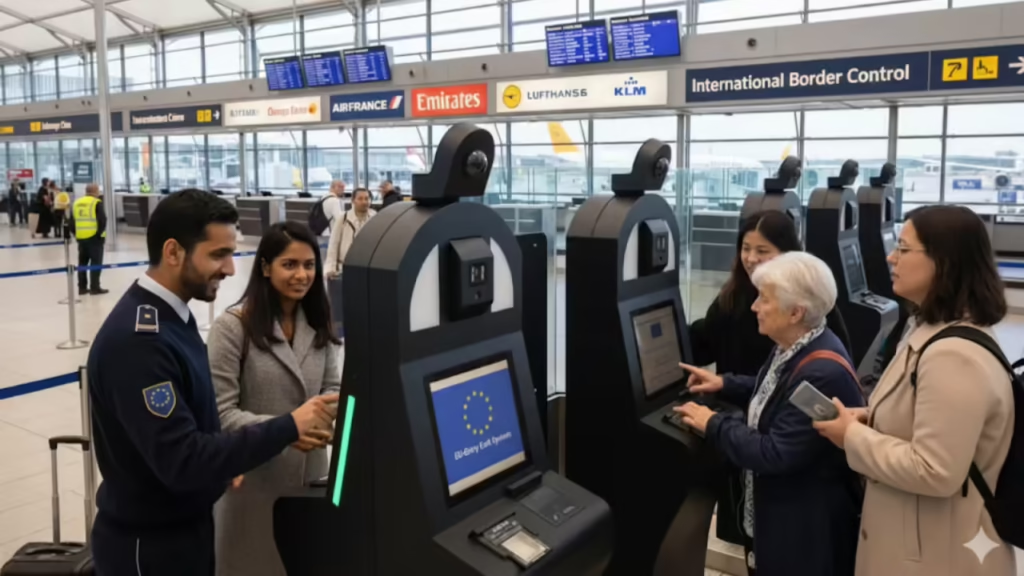EU Entry/Exit System (EES) Introduces Modern Travel Procedures
EU Entry Exit System (EES) has officially gone live, bringing significant changes to how UAE residents and other non-EU travellers experience European borders. This new system replaces traditional passport stamping with digital entry and exit records, aiming to enhance security and streamline travel. By capturing key information such as travel document details, photos, and in some cases fingerprints, the EES ensures faster, more efficient processing while improving border management. The system marks a major step forward in modernising EU travel procedures.
How the EU Entry Exit System (EES) Works
The EU Entry Exit System (EES) records entries and exits electronically, replacing manual passport stamping at borders. It collects essential biographic and biometric data, allowing authorities to accurately track travellers and prevent overstays. For UAE travellers, this means slightly new procedures at airports, including data verification and potential biometric checks. The digital approach helps make border crossings more predictable and secure while maintaining compliance with EU travel regulations.
Impact on UAE–Europe Travel
For UAE residents and citizens, the EES will slightly alter the process when travelling to Schengen Area countries. Although the changes do not restrict travel, they do introduce additional checks and data collection procedures. Passengers will need to ensure their travel documents are valid, complete, and compliant with EU requirements. Airlines and travel operators are also adjusting their procedures to align with the EES, meaning travellers may experience slightly longer processing times at airports initially.

Benefits of the EES
The new system is designed to provide multiple benefits for both travellers and authorities. By digitising entry and exit records, EES helps to streamline airport procedures and reduce errors associated with manual stamping. It also enhances security by allowing authorities to quickly identify individuals with overstayed visas or irregular travel history. For travellers, this can lead to faster border clearance and a more predictable travel experience. Over time, EES is expected to make journeys smoother and safer for everyone entering or leaving the EU.
What UAE Travellers Need to Know
UAE travellers should familiarise themselves with the EES procedures before visiting Europe. Key points include:

- Valid Passport: Ensure your passport has at least six months of validity beyond your planned stay.
- Electronic Data Recording: Be prepared for your personal data to be captured electronically.
- Fingerprinting and Photo: Some travellers may undergo biometric verification for identity confirmation.
- Visa Compliance: Those requiring a visa should check that their documents are in order before travel.
By understanding these requirements, UAE travellers can avoid delays and enjoy a smoother entry process at EU borders.
Changes at Airports
Airports across Europe have adapted to the EES by installing new automated gates and systems for electronic data collection. Passengers entering through these gates may experience quicker processing times, but they should follow signage and instructions carefully. Airport staff are also trained to assist travellers with questions about the system, ensuring that even first-time users can navigate the process efficiently.
Implications for Airlines
Airlines operating UAE–Europe routes are updating their check-in and boarding procedures to align with EES requirements. Staff are verifying that passengers’ travel documents meet EU standards and that biometric data collection can proceed smoothly. This coordination between airlines and border authorities is crucial for reducing delays and maintaining an efficient travel experience. For travellers, this means cooperating with staff during check-in and being aware of any additional documentation or procedures.
Enhancing Security Across Europe
One of the main goals of the EES is to improve security across EU borders. By electronically tracking entries and exits, authorities can more easily detect overstays, prevent illegal immigration, and identify potential security risks. This proactive approach benefits both EU residents and visitors, creating a safer travel environment. While some travellers may initially view the system as more complex, its security benefits and long-term efficiency are substantial.
Travel Tips for UAE Residents
To ensure a hassle-free experience, UAE travellers should consider the following tips:
- Arrive Early: Give yourself extra time at airports, especially during the first weeks of EES implementation.
- Check Travel Requirements: Confirm visa validity, passport details, and airline instructions before departure.
- Be Patient: Follow the instructions at automated gates and biometric stations carefully.
- Stay Informed: Keep updated with EU travel advisories and airport announcements related to EES.
These simple precautions can make the transition to the new system smoother and reduce the stress of travel.
Potential Challenges
While the EES is designed to improve efficiency, some initial challenges may arise. Travellers unfamiliar with electronic data recording may require assistance, and minor delays could occur during peak travel periods. Airports and airlines are actively managing these situations, but patience and preparation will be key for a smooth experience. It is also important for travellers to report any technical or procedural issues to airport staff promptly.
EES and Future Travel
The launch of EES is part of a broader move towards digitised border management in Europe. Over time, the system is expected to integrate with other EU travel initiatives, such as the upcoming European Travel Information and Authorisation System (ETIAS). For UAE travellers, this represents a shift toward more seamless, predictable, and secure international travel. Those who adapt quickly to these changes will benefit from faster processing and enhanced travel experiences.
How EES Affects Tourism and Business Travel
Tourism and business travel between the UAE and Europe are likely to see minimal disruption in the long term, but there may be a learning curve for some passengers. Business travellers, in particular, should plan their trips with additional time for border procedures. Tourism operators and travel agencies are actively providing guidance to clients, ensuring that holidaymakers understand what to expect when travelling to Europe under the new system.
Advantages for Frequent Travellers
For frequent travellers from the UAE, EES offers significant advantages. The automated data collection reduces the need for repeated manual checks, creating a more consistent and predictable travel experience. Over time, travellers who frequently visit Europe may experience faster processing, as the system becomes more familiar and fully operational across all entry points.
Strengthening EU-UAE Travel Relations
The implementation of EES demonstrates Europe’s commitment to secure and efficient travel while maintaining strong relations with countries like the UAE. By modernising border processes and ensuring compliance with travel regulations, the system supports safer, more reliable connections between Europe and the Gulf region. This strengthens business ties, tourism, and cultural exchange between the regions.
Preparing for EES: Practical Steps
Before travelling, UAE residents should take practical steps to ensure smooth processing:
- Verify passport and visa validity
- Familiarise yourself with the EES process online
- Allow extra time at airports during peak travel periods
- Follow instructions carefully at automated gates
Being proactive and informed will reduce stress and help travellers enjoy their European trips with minimal delays.

Long-Term Benefits of EES
In the long term, the EES is expected to create a more efficient travel environment for everyone. By reducing manual stamping, improving security checks, and enhancing border management, the system contributes to faster processing times and more reliable travel documentation. For UAE travellers, this means less uncertainty and a smoother experience when visiting multiple EU countries.
Conclusion
The launch of the EU Entry/Exit System (EES) marks a new era for UAE–Europe travel. While initial adjustments may require patience and preparation, the system promises long-term benefits, including enhanced security, efficient border management, and smoother travel experiences. By understanding and adapting to these changes, UAE travellers can continue to enjoy seamless connections with Europe while benefiting from a modernised, secure, and reliable border process.
Do follow UAE Stories on Instagram














